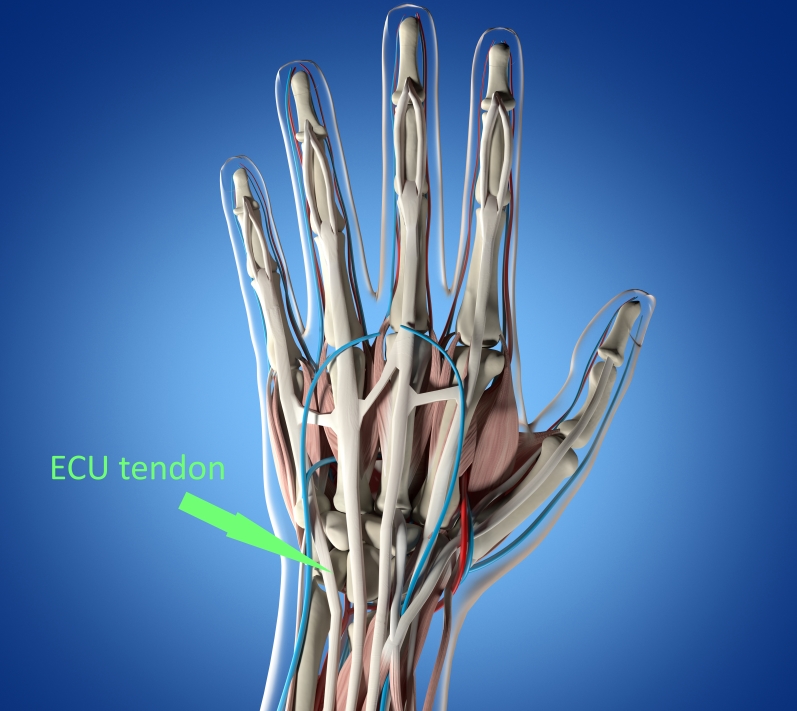The ECU tendon is essential in stabilising the outside or ulnar aspect of the wrist. It can be injured in active individuals or athletes, causing ECU tendonitis, tear, and snapping. What are ECU tendonitis symptoms, and how do we treat it?
What is the Extensor Carpi Ulnaris tendon?

The ECU tendon arises from the ECU muscle, which is attached to the outside of the elbow. As the Extensor Carpi Ulnaris tendon reaches the wrist, it passes through a tunnel in the distal part of the ulna. A strong sheath attached to the bone maintains the tendon in the tunnel.
The tension on the ECU tendon is most significant when the wrist is rotated with the palm facing up (also known as supination). In sports requiring wrist tension in supination, the ECU tendon is under great strain, leading to injury.
Injuries to the Extensor Carpi Ulnaris tendon include:
- ECU tendonitis
- Extensor Carpi Ulnaris tendon tear
- ECU snapping or subluxation
Symptoms of ECU Tendonitis
Repeated movement in competitive sports can irritate the ECU tendon and tendon sheath. The most common sports in ECU tendon pathology include golf, tennis and contact sports such as rugby.
Generally, pain from ECU tendonitis is felt at the ulnar (outside) part of the wrist. Pain can initially warm up with more activity but worsen afterwards. As the pain worsens, people can feel pain with daily activities such as grabbing objects. Other symptoms include swelling, weakness and decreased range of motion. Any popping, snapping or tearing may indicate tearing of the sheath, which could lead to ECU snapping or subluxation.
ECU tendonitis diagnosis
Your doctor must examine your wrist to confirm the diagnosis of ECU tendonitis and exclude other causes. Many causes of ulnar (outside) wrist pain need exclusion. Some other causes of outside wrist pain include TFCC tear, lunotriquetral ligament injury, and distal radioulnar joint arthritis.
Usually, tenderness is found on palpation of the ECU tendon. Also, extending the wrist and moving it outward causes pain. A specific test called the ECU synergy test is highly accurate in detecting ECU tendon swelling. This test involves the patient resting their arm with the elbow flexed at 90 ° and the forearm in full supination. On resisted radial abduction of the thumb, the ECU tendon synergistically contracts and can be palpated. Pain along the length of the ECU tendon is due to pathology of the tendon or its sheath.
Imaging helps confirm ECU tendonitis. X-ray shows the positioning of the ulnar and radial bones. Ultrasound shows the tendon and sheath structure. We can also rotate the wrist while looking with ultrasound to assess the stability of the ECU tendon. MRI also sees the tendon structure and excludes other causes of ulnar wrist pain.
Treatment of Extensor Carpi Ulnaris Tendonitis
Generally, we start with simple anti-inflammatory treatments such as ice and topical and oral NSAIDs. Sometimes, we need to use a wrist splint to rest the tendon. After the acute pain settles, exercise therapy is essential to improving tendon pain. It consists of simple isometric and eccentric wrist exercises. As the strength improves, the athlete can tiptoe back into sport.
Extensor carpi ulnaris injection
A cortisone injection in the tendon sheath can help in cases that fail simple treatments. Generally, we use ultrasound guidance to improve accuracy and effectiveness. Also, ultrasound prevents cortisone injection into the tendon, weakening the tendon and increasing the risk of a complete rupture.
We place a small needle in the tendon sheath close to the ECU tendon groove. Initially, we use a small dose of a local anaesthetic to reduce pain and to create space in the tendon sheath so that cortisone can be accurately injected.
Generally, sportspeople need to be cautious of cortisone because it can weaken and rupture tendons. Some doctors are using PRP injections as an alternative to inflammatory injections, as the rupture risk is much less.
Surgery
We should only consider invasive surgery for ECU tendonitis if simple treatments and an injection do not help. Some surgeons perform a compartment release, connecting the ECU space with the tendons next to it.
Other problems with the ECU tendon
ECU snapping or subluxation
ECU snapping can occur if the tendon sheath is torn. This tearing can occur acutely during sports or gradually with repetitive activity. Generally, people report pain and swelling in the wrist associated with a popping or clicking sensation. The tendon moves out of the groove when the wrist is rotated with the palm up (supinated) and back into the groove when the wrist is rotated with the palm down (pronated).
Often, we use ultrasound to see the tendon moving out of the groove with wrist rotation.
If ECU snapping occurs from an acute injury, we immobilise the wrist and forearm in a cast for a few months. Surgery may be needed to place the tendon correctly if casting is ineffective.
Other frequently asked questions about Extensor Carpi Ulnaris tendonitis:
How long does it take ECU tendonitis to heal?
There is no set time for ECU tendon healing. However, like other causes of tendonitis, ECU tendonitis can take 3-6 months to settle.
Where is the Extensor Carpi Ulnaris tendon located?
The Extensor Carpi Ulnaris tendon is located at the back and outside of the wrist. The tendon attaches to the base of the 5th metacarpal (little) bone.
Does ECU tendonitis occur in non-sporting individuals?
Not usually. However, sedentary people with inflammatory arthritis can present with swelling of the ECU tendon. Sometimes, ECU tendonitis is the first sign of inflammatory arthritis.
Final word from Sportdoctorlondon about ECU tendonitis
ECU tendonitis is common in certain sports, such as golf, tennis, and rugby, and causes pain on the outside of the wrist. You should see a sports doctor who can diagnose and manage your wrist pain.



Leave A Comment